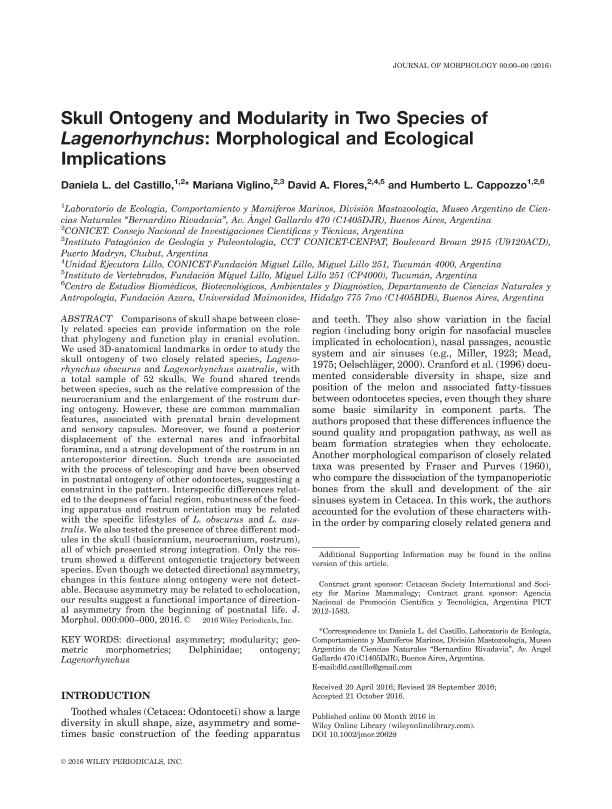Mostrar el registro sencillo del ítem
dc.contributor.author
del Castillo, Daniela Laura

dc.contributor.author
Viglino, Mariana

dc.contributor.author
Flores, David Alfredo

dc.contributor.author
Cappozzo, Humberto Luis

dc.date.available
2018-02-09T18:15:35Z
dc.date.issued
2016-11-17
dc.identifier.citation
del Castillo, Daniela Laura; Viglino, Mariana; Flores, David Alfredo; Cappozzo, Humberto Luis; Skull Ontogeny and Modularity in Two Species of Lagenorhynchus: Morphological and Ecological Implications; Wiley; Journal of Morphology; 278; 2; 17-11-2016; 203–214
dc.identifier.issn
0362-2525
dc.identifier.uri
http://hdl.handle.net/11336/36328
dc.description.abstract
Comparisons of skull shape between closely related species can provide information on the role that phylogeny and function play in cranial evolution. We used 3D-anatomical landmarks in order to study the skull ontogeny of two closely related species, Lagenorhynchus obscurus and Lagenorhynchus australis, with a total sample of 52 skulls. We found shared trends between species, such as the relative compression of the neurocranium and the enlargement of the rostrum during ontogeny. However, these are common mammalian features, associated with prenatal brain development and sensory capsules. Moreover, we found a posterior displacement of the external nares and infraorbital foramina, and a strong development of the rostrum in an anteroposterior direction. Such trends are associated with the process of telescoping and have been observed in postnatal ontogeny of other odontocetes, suggesting a constraint in the pattern. Interspecific differences related to the deepness of facial region, robustness of the feeding apparatus and rostrum orientation may be related with the specific lifestyles of L. obscurus and L. australis. We also tested the presence of three different modules in the skull (basicranium, neurocranium, rostrum), all of which presented strong integration. Only the rostrum showed a different ontogenetic trajectory between species. Even though we detected directional asymmetry, changes in this feature along ontogeny were not detectable. Because asymmetry may be related to echolocation, our results suggest a functional importance of directional asymmetry from the beginning of postnatal life.
dc.format
application/pdf
dc.language.iso
eng
dc.publisher
Wiley

dc.rights
info:eu-repo/semantics/openAccess
dc.rights.uri
https://creativecommons.org/licenses/by-nc-sa/2.5/ar/
dc.subject
Directional Asymmetry
dc.subject
Modularity
dc.subject
Geometric Morphometrics
dc.subject
Delphinidae
dc.subject.classification
Otras Ciencias Biológicas

dc.subject.classification
Ciencias Biológicas

dc.subject.classification
CIENCIAS NATURALES Y EXACTAS

dc.title
Skull Ontogeny and Modularity in Two Species of Lagenorhynchus: Morphological and Ecological Implications
dc.type
info:eu-repo/semantics/article
dc.type
info:ar-repo/semantics/artículo
dc.type
info:eu-repo/semantics/publishedVersion
dc.date.updated
2017-12-04T18:20:39Z
dc.journal.volume
278
dc.journal.number
2
dc.journal.pagination
203–214
dc.journal.pais
Estados Unidos

dc.journal.ciudad
Hoboken
dc.description.fil
Fil: del Castillo, Daniela Laura. Consejo Nacional de Investigaciones Científicas y Técnicas. Oficina de Coordinación Administrativa Parque Centenario. Museo Argentino de Ciencias Naturales “Bernardino Rivadavia”; Argentina
dc.description.fil
Fil: Viglino, Mariana. Consejo Nacional de Investigaciones Científicas y Técnicas. Centro Científico Tecnológico Conicet - Centro Nacional Patagónico. Instituto Patagónico de Geología y Paleontología; Argentina
dc.description.fil
Fil: Flores, David Alfredo. Consejo Nacional de Investigaciones Científicas y Técnicas. Centro Científico Tecnológico - Tucumán. Unidad Ejecutora Lillo; Argentina. Fundacion Miguel Lillo. Direccion de Zoologia. Instituto de Vertebrados; Argentina
dc.description.fil
Fil: Cappozzo, Humberto Luis. Consejo Nacional de Investigaciones Científicas y Técnicas. Oficina de Coordinación Administrativa Parque Centenario. Museo Argentino de Ciencias Naturales “Bernardino Rivadavia”; Argentina
dc.journal.title
Journal of Morphology

dc.relation.alternativeid
info:eu-repo/semantics/altIdentifier/doi/http://dx.doi.org/10.1002/jmor.20629
dc.relation.alternativeid
info:eu-repo/semantics/altIdentifier/url/http://onlinelibrary.wiley.com/doi/10.1002/jmor.20629/abstract
Archivos asociados
